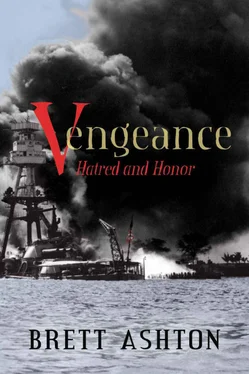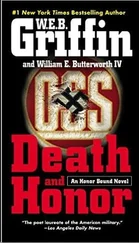One of the runners returned at that time and reported to me the bow was down to three feet of freeboard on the starboard side. The flooding was slowing, but the bow was still sinking, and the list was now passing twenty five degrees. All voids usable for counter flooding, aft and port, were filled to capacity. It didn’t look like it would be possible to keep the starboard bow above water using any conventional methods.
“Tell him he has permission to flood other non-combat related compartments aft and port if needed to stabilize the ship. He can even flood the hangar area if he has to, but only as a last resort because we don’t want to take on too much free water in case of heavy seas.”
“Also tell him,” I continued, “I am going to give the engine room the chance to make their repairs on the engines starting now. Be prepared to rig for tow as soon as the Lawe is along side of us.”
I told the talker to inform the engine room that it was time for them to start their repairs, and I wanted to know when we would be able to have propulsion again.
The sun would be setting in about four hours, and it was dangerous to sit still in the water for that time, so we would have to be prepared to have the Lawe tow us for awhile.
“All stop,” I ordered the helm. And soon after that, the Buffalo was dead in the water.
That was a hard set of orders to give. Taking on more water would set the ship lower in the ocean than we wanted to be. There was no chance we could survive another torpedo or maneuver effectively in case of an air attack with all of that water on board and only our aft engines. All of the unrestrained water we were taking on would seriously affect the stability of the ship, even for a potential tow, and would have to be pumped out before we could hope to sustain even moderate seas. But most of all, I hoped the planes and destroyers would keep the Jap sub from coming up to attack us again.
About half an hour later, the Lawe was alongside, and the admiral, his staff, and most of the injured that were able to be moved were transferred off. The tow was rigged at what seemed like a record pace, and soon, we were making a creeping three to four knots. Not nearly fast enough to evade attack, but at least our position was changing, so hopefully we would not be as easily found by other Japs.
One of the two float planes was lowered into the water by crane and took off to help with the hunt for the submarine that fired on us. I didn’t really have any hope it would be found, but I couldn’t leave the ship exposed any more than I had to. They were probably very deep and silent and creeping away by then. That’s what I would have done. Hopefully, the planes would be able to give us early warning of further attack and keep us covered until nightfall.
A short time later, the Fletcher and the Barton began dropping depth charges, which were most likely more ceremonial than effective. After awhile, they moved into formation with us in a flanking position.
As the remainder of the afternoon passed, Lieutenant Commander Schuller continued to send runners with damage reports on a regular basis.
The counter flooding eventually stopped the ship from listing further, but the bow continued to sink slowly for awhile. It finally stopped with a thirty-one degree list and a very meager eighteen inches between the main deck on the starboard side and Davy Jones’s locker.
Keeping up with the continuous damage reports made the rest of the day fly by at an extremely quick pace. Plans were put in action to move as much of the ship’s stores to the port side aft to act as a counterbalance to the extreme amount of water which now flooded the forward starboard part of the ship. At the same time, as many pumps as possible were working on removing spilled fuel oil and water from the flooded compartments.
The engine repairs were proceeding at a very rapid pace, and soon, the ship’s aft propulsion system would be back online, operating at nearly one hundred percent.
I have never seen a ship’s crew operate in such a united and single-minded fashion before. It soon became apparent we would be able to save our ship.
The major factor in the damage control efforts, besides the effectiveness of the crew, was that we never lost electrical power.
But there was one thing about the whole situation which really tore me up inside and that was the twenty-one trapped crewmen. It’s not only that they were trapped, but it was my order to flood those spaces that trapped them. I tried to tell myself it was the only way to save the ship. If the fuel in the ammunition magazines would have caught fire, the bow would have been blown right off and those men would surely have died anyway. But that didn’t help me. The simple fact was, it was my order to secure and flood those areas that trapped them.
For the last several years, I had tried over and over to come to terms with the loss of the Oklahoma ’s crew. Ensign Flaherty, who won the Medal of Honor and served directly under my command, stung me the most. The loss of such a bright and talented officer, who was properly honored as one of America’s greatest heroes, still hurts me to this day.
For most of the crew that was lost on the Okie , death came very slowly. The idea of being trapped inside the hull of a sinking ship filled me with the most acute terror. Let alone the fact of no food, water, or even light. They went to their deaths slowly, starved and thirsty, not knowing if there was ever a hope of rescue. For the most part, they didn’t even know who had attacked them.
While the latter didn’t apply to the men who were trapped several decks below me, most of the former certainly did.
The basic problems in getting them out were they were surrounded by either very thick armored bulkheads or a flammable mixture of seawater and fuel, not to mention several tons of high explosives.
The compartment above them was flooded to about five feet. The compartment to the starboard was exposed to the ocean. Forward and port were thick armored bulkheads. If we tried to cut through them using torches, we would have created a huge fire hazard, and they were in a room full of explosives. And it was probable that the fumes of cutting through something that thick would have killed them anyway, which was what happened to several of the crew from the Oklahoma when rescue attempts were made there.
The normal direction to exit that compartment was aft, and it was completely flooded. The efforts to pump it out were slow because there were still some major leaks around it that needed to be plugged.
Two things really added urgency. One was the total lack of ventilation to them. The other was the condition of the bulkhead. The one officer inside that compartment, Ensign Gomez, reported that the starboard bulkhead was bulged when the torpedo hit. It had some stress cracks and groaned from time to time but so far remained watertight. How long could they be able to hold out without fresh air? And how long would that bulkhead hold?
Just before sunset, Lieutenant Commander Schuller showed up on the bridge to give the report in person and get authority to reorganize the crew into different working parties to better cover periods of rest and work between the crew. The efforts to transfer solid weight inside the ship as a counterbalance to the floodwater had begun in earnest as well as the removal of flood water. The ship had leveled out to about twenty-seven degrees, and the freeboard on the starboard side had increased to about two and a half feet.
When he had finished his report, I asked him how the trapped crew was doing. The grim expression on his face told me he was expending every effort he could to get those men out, but he didn’t have a lot of hope. He said our first priority was to pump out the compartment above them and drill a hole through to provide some fresh air.
Читать дальше












